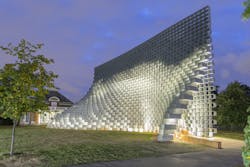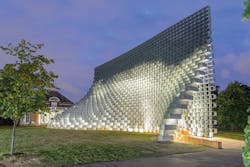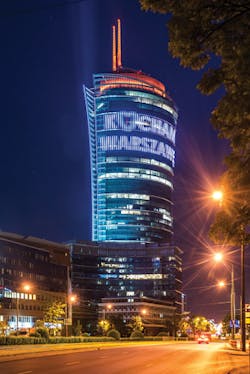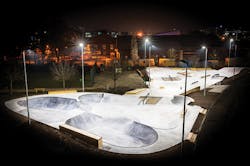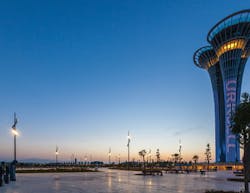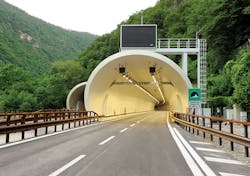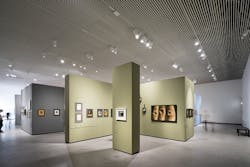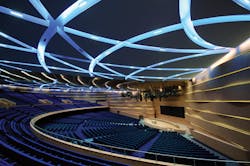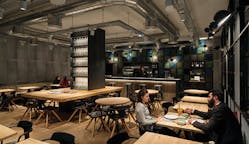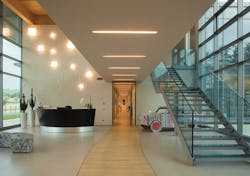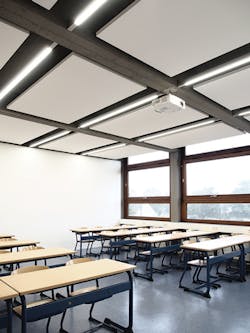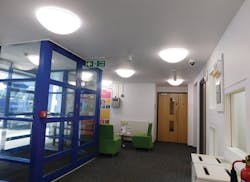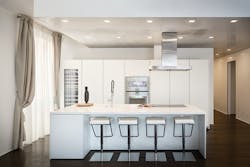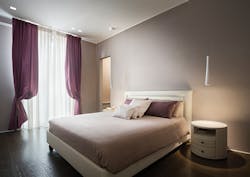The European region, both on the continent and in the UK, has been among the most aggressive global regions in adopting LED lighting. As this article will demonstrate, recent projects include standard outdoor lighting; elegant indoor architectural projects; compelling entertainment, artistic, and façade lighting; and the highest quality lighting for demanding settings such as retail and museums. MAURY WRIGHT compiles case studies including all European regions, making it clear that LED technology is no longer limited to regions with the most successful economies. Indeed, we include a project in Latvia and even one in North Africa - which is admittedly outside Europe but is in a city that has a decidedly European influence and vibe. Top designers from around the European region were behind these projects and lighting designers/specifiers everywhere, as well as solid-state lighting (SSL) product developers, will learn about the latest demands in the lighting sector.
London's Serpentine Pavilion 2016
Architecture firm Bjarke Ingels Group (BIG) created the Serpentine Pavilion 2016 project located at London's Serpentine Galleries, contemporary art galleries located in Kensington Gardens. The 14m structure is composed of translucent blocks that the architect conceived as being unzipped to reveal a large indoor space that hosts a café and a bar, and has been used as an evening event venue for the Serpentine Park Nights program. The lighting for the structure was supplied by Zumtobel's acdc Lighting brand. The structure is made of stacked translucent fiberglass frames and Ingels wanted to create a lighting effect that glowed from the base with the light grazing up the walls to reveal the architecture, while dimming to a low level at the apex and dissolving into the dark sky. The luminaires were intended to be hidden from view. A team from engineering firm Aecom and Zumtobel undertook the lighting design. Aecom specified that 100 lx was required on the floor, 200 lx on the bar, and an average of 10 lx on emergency exit routes. Zumtobel simulated the design after measuring the optical transmission properties of the rectangular fiberglass elements and ultimately determined that the requisite light levels could not be achieved solely by uplights because of the optical properties of the fiberglass and the fact that the walls slope inward and could cause glare with higher light levels used. Ultimately, the team settled on uplight delivered from luminaires hidden behind perimeter bench seating and some acdc Plaza 10 spotlights located at 4.3m above the floor. Plaza 20 luminaires were used behind the benches with wide elliptical beam patterns to create a uniform grazing effect. "It was important for us that the lighting at night would enhance the geometry of the structure and be coherent with the perception of the pavilion during daytime," said Maria Sole Bravo, a senior designer at BIG. "The fiberglass boxes become thinner higher up in the building, making the structure lighter and more translucent. Following that same expression, the lighting from the ground makes the lower boxes brighter and allows the top of the structure to dissolve in the darkness."
Warsaw Spire architectural lighting
The second tallest building in Poland, measuring 220m in height, now features the largest installation of Philips Color Kinetics lighting in Central Eastern Europe. Indeed, the recently constructed Warsaw Spire, located in the central business district, features dynamic color-tunable lighting on the façade of the structure located 160m above ground level. There are symmetric installations on each side of the building measuring almost 40m tall. In total there are 80,000 individually-controllable light points in iColor Flex strand-based lighting products. Moreover, ColorGraze MX4 luminaires light the roof of the building and ColorReach Powercore luminaires light the spires atop the roof. The building owners used the lighting to send the message "I love Warsaw" to citizens during the construction of the building. "The illumination on the Warsaw Spire is a part of our idea to open the buildings to the city and people," said Jeroen van der Toolen, managing director of building developer Ghelamco. "For example, during the UEFA Euro 2016 football tournament, we supported the Polish team and presented the results of the matches. This allows the building to come alive with the city's highlights." Meanwhile, the lighting can be controlled with a simple mobile device. Philips said it uses 75% less energy than conventional building façade lighting and can be seen from kilometers away.
Karlsruhe skate park
Outdoor recreational facilities are ripe for LED-based lighting as prices drop, enabling municipalities and businesses to leverage energy savings, but a project at a skate park revealed another surprising angle - the need for flicker-free lighting and how the latest SSL products can deliver. Osram supplied its Floodlight 20 generation of luminaires to the new skate park located in Karlsruhe, Germany, working in partnership with lighting design firm DSGN Concepts from Münster. The requirements of the project included lighting that would enable recording of skating tricks for training and sharing purposes. "Much is filmed during skating," said Ingo Naschold, managing director of DSGN Concepts. "Recordings in superslow motion are especially popular because these best communicate the ability of the individual athletes as well as a strong sense of emotion. In this respect it's important that the slow motion is flicker-free. This we've achieved with the lighting." Osram said that even smartphone slow-motion recordings rely on frame rates in the 120 to 240 fps (frames per second) range and that other cameras may use rates as high as 480 fps. With many electric lighting products, fluctuations that go unseen by the human eye can be captured by cameras with each frame in a series having a different light level. Osram developed the Floodlight 20 just for such applications as the skate park. The company said it applied lessons learned from lighting professional sports playing fields in the luminaires that target recreational facilities. And Naschold found the floodlights a good match for the skate park project, saying, "For the new construction of the skate park in Karlsruhe we managed to find a partner in Osram that enabled implementation of this creative concept professionally and at a maximum level in terms of lighting technology."
Turkey EXPO 2016
Antalya, Turkey hosted its first global exhibition in 2016 with the EXPO 2016 horticultural exhibition taking place starting in April and running through October. The event was situated on a 112-hectare space that required significant area lighting, and the lighting needed to be aligned with the nature and sustainability focus of the event that officially used the motto "Flowers and children." Niyazi Avcı, a lighting designer from Ankara, selected Selux to supply the lighting systems. There were many elements to the project, but the most notable installations are 15m poles that each have 15 Selux Olivio Grande heads installed in a spiral fashion around the poles. The poles were located at the main entrance and prominent locations near the EXPO tower and square. The design was intended to create a natural and inviting environment, and in fact the luminaires in the Olivio Sistema design line have what Selux calls a floral organic shape, which was symbiotic with the horticultural theme of the fair. In other areas such as walkways and around the VIP building and press center, Selux Astro area luminaires provided a round symmetrical light distribution. Those low-profile luminaires also have a blue effect ring surrounding the light engine that adds a touch of style to the scene and what Selux called "a pleasantly sobering contrast" to the higher-profile poles.
Italy Brenner Highway tunnels
Europe features many more highway tunnels than do other regions of the globe, and safely lighting such tunnels is imperative with drivers moving through open space with sun exposure and tunnels repeatedly on many routes. Cree recently supplied new lighting on the A22 Brenner Highway - an important route that connects the Italian Po Valley with the A1 Highway and ultimately with Austria and Germany. The Castelrotto and Sant'Osvaldo tunnels, located near the town of Castelrotto, Italy had been lit conventionally back in 1964, but that lighting did not produce the light levels recommended by current regulatory agencies. The Autostrada del Brennero S.p.A. highway management company located in Trento had been working on a plan for relighting the tunnels dating back to 2007, and had originally planned to install a hybrid LED and high-pressure sodium (HPS) system to balance cost and maintenance. But the continuous improvement of LED-based lighting and cost reductions allowed the project to proceed using all LED lighting. Ultimately 686 Cree LEDway E-Tunnel luminaires were installed, reducing annual energy use from 746,000 kWh to 435,000 kWh. Perhaps more important, the lighting is much improved for drivers. HPS lamps have notoriously poor color rendering and Cree said the transition by drivers from full sun to the tunnel lighting is much smoother due to the relatively higher CRI of the LED luminaires. Moreover, the new lighting can be operated at 75% of full power and still meet the regulatory requirements. The system is expected to operate for 140,000 hours.
Latvia National Museum of Fine Arts
Europe is renowned for its many museums and increasingly such institutions are turning to LEDs to light their treasured works of art. For example, we covered a major LED retrofit of the Rijksmuseum in Amsterdam a few years back. Initially, the motivation of curators considering a move to SSL was energy efficiency and low maintenance requirements. But increasingly with improvements in LED technology, a move to SSL can improve the visitor experience. The National Museum of Fine Arts in Riga, Latvia on the Baltic Sea has recently completed a retrofit providing visitors what it calls a "multi-sensory experience." The lighting supplied by Linea Light Group was intended to blend the artwork into the surrounding architecture and "guide the viewer emotionally." The project included lighting the baroque-style façade crafted by German architect Wilhelm Neumann along with the indoor space where the art is housed. The majority of the project focused on the art is based on the Sunrise and Vektor projector-style luminaires from Linea. And most of the 1300 luminaires are equipped with DALI (digital addressable lighting interface) network connectivity for remote control. The luminaires are generally installed on ceiling tracks, yet precise beam control ensures that the light is focused on the target artwork.
Algiers Centre International Conferences
While Algiers lies on the south side of the Mediterranean Sea as opposed to the European continent, the city has a distinctly European feel to it and indeed was under French rule for many years. The city recently constructed the largest convention center in North Africa - the Centre International Conferences (CIC) - and the congress center presented a variety of lighting challenges. The design was intended to echo local architecture while also featuring what the city called a hypermodern design. The facility has 8045 m2 of glass and 12,160 m2 of marble. The Theveste Auditorium perhaps best symbolizes the challenge with space for 6000 people in 6300 m2 of space. B Light supplied its Inserto Mini Slim CL linear luminaires for the ceiling that creates what the company called light blades. Moreover, color-capable versions of the luminaires provide dynamic highlighting of circular engravings on the ceiling. The designers selected 3000K-CCT LED sources for the project with a very high CRI of 93. A DMX control system underlies the design. Other areas of the CIC have vastly different lighting needs. For example, in the smaller Djmelia conference room that holds 700, Atlas luminaires were inlaid into wooden panels blending into the architecture. Connecting spaces and corridors were lit with Inserto Medium 105 Edge luminaires installed in places such as columns.
OhBo restaurant in Barcelona
Hospitality lighting has been one of the tougher challenges for lighting designers working with LEDs because the legacy halogen lamps often used in spaces such as restaurants provide good CRI and comforting warm-white light. But evolving technology in LED components and lamp and fixture design is allowing SSL to succeed in such a demanding environment. For example, Soraa lamps were installed in a stylish London restaurant recently and we covered a hotel/restaurant renovation in Copenhagen earlier this year. In the Sant Gervasi neighborhood of Barcelona, Lamp Lighting has supplied LED technology in a design intended to match the farm-to-table emphasis of the OhBo restaurant. Isabel López Vilalta + Asociados handled the design with the internal architecture featuring a rustic environment utilizing recovered materials. For the lighting, the firm installed Lamp Lighting's Imag projectors that have a unique housing serving as a stylish shell and heat sink. The products use chip-on-board LED technology to deliver uniform beams on the customer tables.
Fermo Valtenna box factory
Commercial spaces were among the first application sectors to adopt LED-based lighting, led initially by the high electrical cost of lighting. Energy efficiency remains a key driver of SSL adoption in the sector, although the latest designs also reveal the flexibility of LEDs in terms of luminaire form factor and the quality of LED sources. For example, see our article on a German project at the Leica Camera facility. More recently, Linea Light Group has supplied a project by lighting designer Stefano Dall'Osso at the new Valtenna box factory in Fermo, Italy. The company has made sustainability the focus of its planning and manufacturing systems, and sought to carry that theme through the building including the use of natural materials such as wood and glass. Dall'Osso was charged with matching that theme with lighting and including the use of natural light or daylighting where possible. Dall'Osso ultimately developed custom fixtures for the project that included fluorescent sources for direct light and LED-based indirect lighting that was mounted on the walls and diffused into the high ceilings, also highlighting the dramatic exposed wooden surfaces. The building includes automatic dimming based on available natural light with the system programmed to maintain the 500-lx level required by local regulations.
Le Silla footwear office in Porto Sant'Elpidio
Glamour footwear company Le Silla based in Porto Sant'Elpidio, Italy needed a lighting design that might be more akin to high-end retail lighting than to an office and factory building. The employees need to evaluate colors properly in crafting new products, which now include bags and beach fashions in addition to shoes, and the fashion-focused business needed a showplace commensurate with its target customers and distribution chain. Moreover, the company wanted to ensure that the stylish design included sustainability themes including daylighting, and the building uses many glass walls. Ivan Palmini of architecture firm studio ipalmini led the design with lighting supplied by ERCO. The ultimate design was described as minimalist and the recessed lighting continues that trend. LEDs enabled the building to achieve compliance with EN 12464 regulations on light levels while also minimizing the number of fixtures installed. Downlights with flood or wide flood beams directly light work surfaces while wall washers deliver indirect light. Palmini specified 3000K-CCT light, whereas many commercial offices use cooler CCTs. ERCO said the warm lighting provided an ambience that makes working conditions ideal while also rendering the saturated colors of many of the products. The lighting can be smoothly dimmed to 1%.
Theodor Fliedner High School in Dusseldorf
Educational institutions are another application sector where the energy savings inherent in LED lighting led to some early adoption, but clearly the quality of light for the students is a pressing concern. A project at Theodor Fliedner High School in Dusseldorf, Germany highlights some of the advantages afforded by a retrofit to SSL. The school has long used T8 fluorescent lighting as have many educational institutions. But such lighting is far from ideal with potential problems including flicker and the German school worried about harmful mercury in lamps that have to be disposed of on a regular basis. The school turned to LED Linear to deliver an LED-based alternative and has retrofitted seven classrooms, with more scheduled for renovation during breaks in the schedule. The classroom ceilings proved to be a challenge due to exposed beams that ran perpendicular to the way that linear lighting would ideally be installed. LED Linear worked with the school to customize its Xoominaire linear product for the application. Taking advantage of the form factor flexibility inherent in LEDs, the company manufactured luminaires in custom lengths to precisely fit the length of the open ceiling between the beams. The result is virtually continuous runs of linear lighting that is perpendicular to the classroom desk rows. LED Linear said the design optimizes uniformity on both horizontal and vertical surfaces. That means students can see well on the work surface at a desk and when viewing wall-mounted white boards and video screens. The 4000K-CCT lighting outputs 2200 lm/ft.
Oxford Brookes University in the UK
Oxford Brookes University in Oxford, England traces its roots to the nineteenth century, although the university has a reputation as a forward-thinking institution with a renowned architecture school. So it comes as no surprise that the university chose to install a wireless lighting control system across three buildings on campus. The system enabled immediate savings of 30% through adaptive control and dimming based on natural light levels and occupancy. Harvard Technology supplied its EyeNut wireless technology for the project and worked with the school on the control strategy. Harvard audited the lighting in the buildings relative to the Chartered Institute of Building Service Engineer's (CIBSE) interior lighting guide. The exercise revealed that light levels were 15% to 45% higher than CIBSE recommendations. Capping levels based on the CIBSE recommendations enabled the university to reduce energy usage by an additional 27%, bringing total savings to just under 50%. "We never thought that we would be able to achieve such impressive savings by implementing a lighting control system," said Steve Holtom, energy manager at Oxford Brookes. "We are now looking at rolling EyeNut out across further sites, including student residence blocks. Now we have the system in place, installing EyeNut in additional buildings is really easy and cost effective." The university said savings across the three buildings that are attributable to the wireless network equate to £13,000 ($15,885) per year.
Modern residential apartment in Milan
Residential LED lighting applications have largely centered on the traditional lamp form factor, although increasingly lighting manufacturers are truly leveraging small LED sources for all new designs. Buzzi & Buzzi has developed stylish fixtures that use replacement lamps and offer a choice of LED or legacy sources and others that are uniquely LED. The company supplied a variety of products in a residential apartment project in the Porta Garibaldi neighborhood of Milan, Italy, and that project showcases the breadth of LED technology available. Milan is arguably the style capital of Europe, and the design of the apartment certainly screams style. The stark and sleek kitchen is lit with recessed Mini Secret downlights with a white frosted glass diffuser. In the bedroom, lights above nightstands resemble long funnels, and in fact are called Funnel, and are suspended from the ceiling by a relatively long cable. The Funnel products can be dimmed for scene setting. In the bathroom, the company installed its Invisiled LED luminaire recessed in the walls and virtually hidden as a part of the architecture. Buzzi & Buzzi has also been innovative in its adoption of new materials for its luminaires. The products in the apartment project are made of the company's AirCoral material. The company says the material is eco-active, anti-polluting, anti-bacterial, and photocatalytic.
